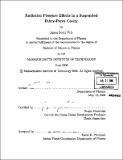| dc.contributor.advisor | Nergis Mavalvala. | en_US |
| dc.contributor.author | Pelc, Jason, 1984- | en_US |
| dc.contributor.other | Massachusetts Institute of Technology. Dept. of Physics. | en_US |
| dc.date.accessioned | 2007-02-21T11:30:07Z | |
| dc.date.available | 2007-02-21T11:30:07Z | |
| dc.date.copyright | 2006 | en_US |
| dc.date.issued | 2006 | en_US |
| dc.identifier.uri | http://hdl.handle.net/1721.1/36124 | |
| dc.description | Thesis (S.B.)--Massachusetts Institute of Technology, Dept. of Physics, 2006. | en_US |
| dc.description | Includes bibliographical references (p. 65-67). | en_US |
| dc.description.abstract | We report on experimental observation of radiation-pressure induced effects in a high-power optical cavity. These effects play an important role in next generation gravitational wave detectors, as well as quantum non-demolition devices. We describe two experiments in which a low-transmission input mirror and near-perfectly-reflective end mirror are suspended as pendulums. A unified model of optomechanical coupling is presented, whereby a strong coherent laser field interacts with a classical harmonic oscillator. We show that such a system is well described using standard techniques from control theory. We measure the properties of an optical spring, whereby the optical field increases the rigidity of the pendulum mode of the mirrors; during our first (Phase 1) experiment, we measure an optical rigidity of K = (3.08 t 0.09) x 104 N/m, corresponding to an optical rigidity that is 6000 times stiffer than the mechanical stiffness. In our second (Phase 2) experiment with higher finesse and lower mirror mass, we find an unprecedented optical rigidity Ko = (9.60 ± 0.12) x 105 N/m. We also measure and characterize the parametric instability, caused by the coupling of the cavity field to the acoustic modes of the mirror, and find an instability strength R - 3. | en_US |
| dc.description.abstract | (cont.) We discuss the noise suppression features of an optically rigid system, and demonstrate a strong-coupling radiation pressure cooling of the mirror motion. A discussion of the path towards a measurement of the quantum mechanical state of the bulk mirror motion in future experiments is included. | en_US |
| dc.description.statementofresponsibility | by Jason Scott Pelc. | en_US |
| dc.format.extent | 67 p. | en_US |
| dc.language.iso | eng | en_US |
| dc.publisher | Massachusetts Institute of Technology | en_US |
| dc.rights | M.I.T. theses are protected by copyright. They may be viewed from this source for any purpose, but reproduction or distribution in any format is prohibited without written permission. See provided URL for inquiries about permission. | en_US |
| dc.rights.uri | http://dspace.mit.edu/handle/1721.1/7582 | |
| dc.subject | Physics. | en_US |
| dc.title | Radiation pressure effects in a suspended Fabry-Perot cavity | en_US |
| dc.type | Thesis | en_US |
| dc.description.degree | S.B. | en_US |
| dc.contributor.department | Massachusetts Institute of Technology. Department of Physics | |
| dc.identifier.oclc | 72455650 | en_US |
